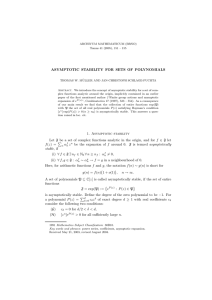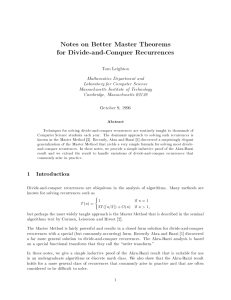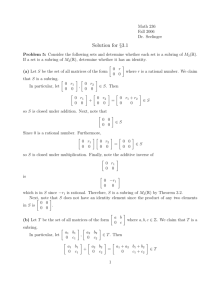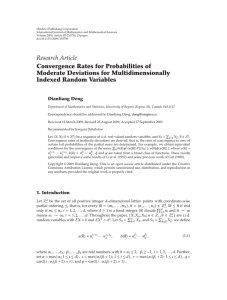Large Sieve Inequalities via Subharmonic Methods T. Erdélyi D.S. Lubinsky
advertisement
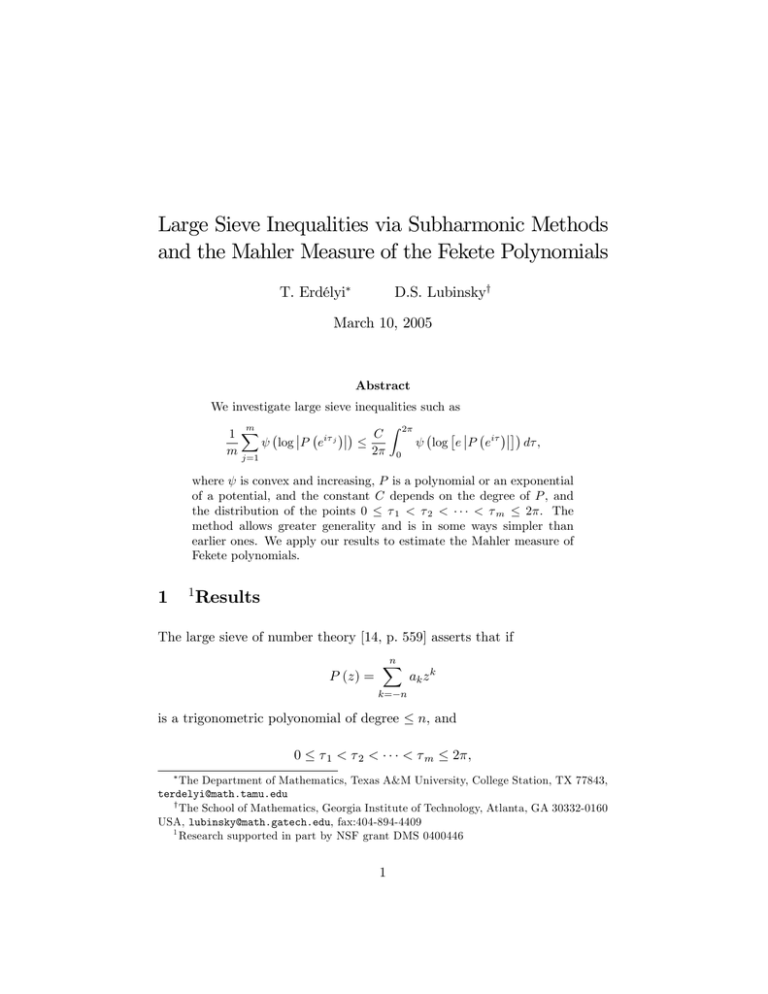
Large Sieve Inequalities via Subharmonic Methods and the Mahler Measure of the Fekete Polynomials D.S. Lubinskyy T. Erdélyi March 10, 2005 Abstract We investigate large sieve inequalities such as Z 2 m C 1 X log P ei j log e P ei m j=1 2 0 d ; where is convex and increasing, P is a polynomial or an exponential of a potential, and the constant C depends on the degree of P , and the distribution of the points 0 < m 2 . The 1 < 2 < method allows greater generality and is in some ways simpler than earlier ones. We apply our results to estimate the Mahler measure of Fekete polynomials. 1 1 Results The large sieve of number theory [14, p. 559] asserts that if P (z) = n X ak z k k= n is a trigonometric polyonomial of degree 0 1 < 2 < n, and < m 2 ; The Department of Mathematics, Texas A&M University, College Station, TX 77843, terdelyi@math.tamu.edu y The School of Mathematics, Georgia Institute of Technology, Atlanta, GA 30332-0160 USA, lubinsky@math.gatech.edu, fax:404-894-4409 1 Research supported in part by NSF grant DMS 0400446 1 and := min f then m X 1; 3 2 i P e j 2; : : : ; m n + 2 2 j=1 m 1; 2 Z 1 2 ( 2 P ei 1 )g ; m d : There are numerous extensions of this to Lp norms, or involving where (1) 0 P ei p is a convex function, and p > 0 [8], [12]. There are versions of this that estimate Riemann sums, for example, m X P ei j 2 ( j j 1) C j=1 with C independent of n, P , f 1 ; 1 2 2 ; : : : ; m g. Z 2 P ei 2 d ; (2) 0 These are often called forward Marcinkiewicz-Zygmund inequalities. Converse Marcinkiewicz-Zygmund Inequalities provide estimates for the integrals above in terms of the sums on the left-hand side [11], [13], [16]. A particularly interesting case is that of the L0 norm. A result of the …rst author asserts that if fz1 ; z2 ; : : : ; zn g are the nth roots of unity, and P is a polynomial of degree n Y j=1 n, jP (zj )j1=n where M0 (P ) := exp 1 2 2M0 (P ) ; Z 2 log P eit (3) dt 0 is the Mahler measure of P . The focus of this paper is to show that methods of subharmonic function theory provide a simple and direct way to generalize previous results. We also extend (3) to points other than the roots of unity. Given c 2 0, 2 , [0; 1), and a positive measure of compact support and total mass at most 0 on the plane, we de…ne the associated exponential of its potential by Z P (z) = c exp log jz tj d (t) : We say that this is an exponential of a potential of mass degree is , and that its . The set of all such functions is denoted by P . Note that if P is a polynomial of degree n, then jP j 2 Pn : More generally, the generalized polynomials studied by several authors [3], [7] also lie in P , for an appropriate . We prove: Theorem 1.1 Let > 0, : R ! [0; 1) be nondecreasing and convex. Let m 1, > 0, and 0< Let wj 0, 1 j 1 2 : m 2 m with m X wj = 1: j=1 Let m denote the corresponding Riemann-Stieltjes measure, de…ned for [0; 2 ] by m ([0; ]) := X j: 2 wj : j Let := sup denote the discrepancy of m X wj i log P e j m ([0; m. ]) : 2 2 [0; 2 ] (4) Then for P 2 P , 1+ 8 1 2 j=1 3 Z 0 2 h log e P ei i d : (5) Example 1 Let us choose all equal weights, 1 ; m wj = Then m 1 j m: is counting measure, m ([0; If we take ]) = 1 # fj : m = 1, and use the notation log+ t = (t) = max f0; tg, and max f0; log tg, we obtain m 1 X + log P ei m 1 ) 2 (1 + 8 j 2 [0; ]g : j j=1 Z h log+ eP ei 2 0 i d : (6) This result is new. Previous inequalities have been limited to sums involving P ei becomes j p (t) = ept , and , some p > 0. If we let p > 0, m 1 X P ei m p j (1 + 8p ) j=1 This choice of e 2 Z 2 p P ei = 1 p, d : (5) (7) 0 is not optimal. The optimal choice is r 1 =4 1+ 1+ 2p but one needs further information on the size of p to exploit this. For q example, if p 1, the optimal choice is of order p , and choosing this in (5), we obtain m 1 X P ei m j p 1+C j=1 p 1 2 p Z 2 P ei p d ; (8) 0 where C is an absolute constant. For well distributed f 1 ; 2 ; : : : ; m g, is of order 1 m. In particular, when these points are equally spaced and include 2 , but not 0, so that j = 2j ; m 1 4 j m; we have 2 ; m = and (7) becomes m 1 X P ei m p j 1+ j=1 e 2 16 p m Z 2 p P ei d : (9) 0 Example 2 Another important choice of the weights wj is wj = where now we assume 0 j j 1 ; 2 = 0 and 1 m j m; = 2 . For this case (5) becomes an estimate for Riemann sums, m 1 X ( 2 j j 1) log P ei j=1 1+ The discrepancy 8 1 2 Z j h log e P ei 2 0 i d : (10) in this case is j = sup j 1 2 j : Remarks (a) In many ways, the approach of this paper is simpler than that in [12] where Dirichlet kernels were used, or that of [8], where Carleson measures were used. The main idea is to use the Poisson integral inequality for subharmonic functions. (b) We can reformulate (5) as Z 2 log P ei d 0 1+ 8 1 2 m( Z 2 0 5 ) h log e P ei i d : In fact this estimate holds for any probability measure m on [0; 2 ], not just the pure jump measures above. (c) The one severe restriction above is that this excludes is nonnegative. In particular, (x) = x. For this case, we prove 2 di¤erent results: Theorem 1.2 Assume that m, , f 1; 2; : : : ; mg and fw1 ; w2 ; : : : ; wm g are as in Theorem 1.1. Let Q (z) = m Y ei z wj j : (11) j=1 Then for P 2 P , m X i wj log P e 1 2 j j=1 Z 2 log P ei d + log kQkL1 (jzj=1) : 0 (12) Remarks If we choose all wj = m Y i P e j 1=m 1 m, this yields kQkL1 (jzj=1) exp j=1 If we take ei 1 ; ei 2 ; : : : ; ei m Z 1 2 2 log P ei d : (13) 0 to be the mth roots of unity, then 1j1=m Q (z) = jz m and (13) becomes m Y i P e j 1=m 2 =m exp j=1 In the case 1 2 Z 2 log P ei d : (14) 0 = m = n, this gives the …rst author’s inequality (3). In general however, it is not easy to bound kQkL1 (jzj=1) . Using an alternative method, we can avoid the term involving Q, when the spacing between successive is O 1 : 6 j Theorem 1.3 Assume that m; and f 1 ; Let 0 := 2 and m m+1 := max f := 1 1 2; : : : ; mg are as in Theorem 1.1. + 2 . Let 0; 2 1; : : : ; m m 1g : Let A > 0. There exists B > 0 such that whenever 1 A then for all P 2 P , m X j+1 j=1 j 1 2 i log P e ; Z j 1 and 2 log P ei d + B: (15) 0 One application of Theorem 1.2 is to estimation of Mahler measure. Recall that for a bounded measurable function Q on [0; 2 ], its Mahler measure is M0 (Q) = exp 1 2 Z 2 log Q ei d : 0 It is well known that M0 (Q) = lim Mp (Q) ; p!0+ where for p > 0, Mp (Q) := kQkp := 1 2 Z 2 Q ei p 0 It is a simple consequence of Jensen’s formula that if Q (z) = c n Y (z zk ) k=1 is a polynomial, then M0 (Q) = jcj n Y k=1 7 max f1; jzk jg : 1=p d : The construction of polynomials with suitably restricted coe¢ cients and maximal Mahler measure has interested many authors. The Littlewood polynomials, Ln := ( p : p (z) = n X kz k ; k k=0 ) 2 f 1; 1g ; which have coe¢ cients 1, and the unimodular polynomials, ( ) n X k Kn := p : p (z) = kz ; j kj = 1 k=0 are two of the most important classes considered. Beller and Newman [1] constructed unimodular polynomials of degree n whose Mahler measure is p at least n c= log n. Here we show that for Littlewood polynomials, we p can achieve almost 12 n, by considering the Fekete polynomials. For a prime number p, the pth Fekete polynomial is fp (z) = p 1 X k=1 k p zk ; where k p 8 > if x2 k (mod p) has a non-zero solution x <1; = 0; if p divides k > : 1; otherwise. Since fp has constant coe¢ cient 0 it is not a Littlewood polynomial, but gp (z) = fp (z) =z is a Littlewood polynomial, and has the same Mahler measure as fp . Fekete polynomials are examined in detail in [2, pp. 37–42]. Theorem 1.4 Let " > 0. For large enough prime p, we have M0 (fp ) = M0 (gp ) 8 1 2 " p p: (16) Remarks From Jensen’s inequality, M0 (fp ) However 1 2 kfp k2 = p p 1: " in Theorem 1.4 cannot be replaced by 1 ". Indeed if p is prime, and we write p = 4m + 1, then gp is self-reciprocal, that is, zp 1 1 z gp = gp (z) ; and hence (p 3)=2 gp e2it = ei(p 2)t X ak cos ((2k + 1) t) ; ak 2 f 2; 2g : k=0 A result of Littlewood [10, Theorem 2] implies that Z 2 1 M0 (fp ) = M0 (gp ) gp e2it dt (1 2 0 "0 ) p p 1; for some absolute constant "0 > 0. It is an interesting question whether there is a sequence of Littlewood polynomials (fn ) such that for an arbitrary " > 0, and n large enough, M0 (fn ) (1 p ") n: The results are proved in the next section. 2 Proofs We assume the notation of Theorem 1.1. We let r =1+ ; and de…ne the Poisson kernel for the ball jzj Pr sei ; reit = (17) r (cf. [15, p. 8]), r2 s2 2rs cos (t r2 9 ) + s2 ; where 0 s < r and t; 2 R. Proof of Theorem 1.1 Step 1 The Basic Inequality Let P 2 P n f0g, so that for some c > 0 and some measure mass with total and compact support, log P (z) = log c + As log P is subharmonic, and as Z log jz tj d (t) : is convex and increasing, (log P ) is subharmonic [15, Theorem 2.6.3, p. 43]. Then we have for jzj < r, the inequality [15, Theorem 2.4.1, p. 35] Z 2 1 (log P (z)) log P reit 2 0 Pr z; reit dt: Choosing z = ei j , multiplying by wj , and adding over j gives m X wj i log P e j=1 1 2 Z 2 j 1 2 Z 2 log P reit dt 0 log P reit H (t) dt wj Pr ei j ; reit 1 0 (18) where H (t) : = = m X j=1 2 Z 0 Pr ei ; reit d m( ) 2 : Here we have used the elementary property of the Poisson kernel, that it integrates to 1 over any circle center 0 inside its ball of de…nition. Step 2 Estimating H We integrate this relation by parts, and note that both 10 m [0; 0] = 0 and m [0; 2 ] = 1. This gives Z 2 @ H (t) = Pr ei ; reit @ 0 and hence Z jH (t)j 2 @ Pr ei ; reit @ 0 Now m ([0; ]) d : r2 1 2r sin (t ) @ Pr ei ; reit = @ (r2 2r cos (t ) + 1)2 so a substitution s = t and 2 periodicity give Z Z 2 @ @ Pr ei ; reit d = Pr eis ; r ds @ @s 0 Z @ = 2 Pr eis ; r ds 0 @s = 2 Pr ei ; r d 2 Pr (1; r) = (19) 8r r2 1 : (20) Combining (18)–(20), gives m X wj i log P e j 1+ j=1 8r r2 1 1 2 Z 2 log P reit dt: (21) 0 Step 3 Return to the unit circle Next, we estimate the integral on the right-hand side in terms of an integral over the unit circle. Let us assume that has total mass ( r z S (z) = jzj P so that log S (z) = log c + Z ). Let log jr tzj d (t) ; a function subharmonic in C. Then the same is true of (log S), so its integrals over circles centre 0 increase with the radius [15, Theorem 2.6.8, p. 46]. In particular Z 2 1 log S ei 2 0 1 2 d 11 Z 0 2 log S rei d and a substitution ! gives Z 2 1 log P rei d 2 0 Z 2 1 2 0 Z 2 1 2 0 Z 2 1 2 0 log r + log P ei d log r + log P ei d + log P ei d ; recall our choice (17) of r. Then (21) becomes m X wj log P ei j j=1 8r 1+ r2 1+8 1 1 2 Z 2 1 2 0 Z 0 h log e P ei 2 i h log e P ei i d d : Proof of Theorem 1.2 Write log P (z) = log c + so m X wj log P ei j = log c + j=1 = log c + Z Z Z log jz tj d (t) 0 m X @ wj log ei j j=1 log Q (t) d (t) ; 1 t A d (t) (22) recall (11). Now as all zeros of Q are on the unit circle, g (u) := log Q (u) log kQkL1 (jzj=1) log juj is harmonic in the exterior fu : juj > 1g of the unit ball, with limit 0 at 1, and with g (u) 0 for juj = 1. By the maximum principle for subharmonic functions, g (u) 0; juj > 1: 12 We deduce that for juj > 1, log Q (u) log kQkL1 (jzj=1) + log+ juj : Moreover, inside the unit ball, we can regard Q as the absolute value of a function analytic there (with any choice of branches). So the last inequality holds for all u 2 C. Then assuming (as above) that Z Z log Q (t) d (t) log kQkL1 (jzj=1) + log+ jtj d Z Z 2 1 = log kQkL1 (jzj=1) + 2 0 Z 2 Z 1 log kQkL1 (jzj=1) + 2 0 has total mass , (t) log ei t d log ei t d (t) d : d (t) (23) In the second line we used a well known identity [15, Exercise 2.2, p. 29], and in the last line we used the fact that the sup norm of Q on the unit circle is larger than 1. This is true because Z 2 Z 2 m X 1 1 log Q ei d = log ei wj 2 0 2 0 ei d = 0; j j=1 while log Q < 0 in a neighborhood of each j, so that log Q ei > 0 on a set of of positive measure. Substituting (23) into (22) gives Z 2 m X 1 i j log kQkL1 (jzj=1) + wj log P e log P ei 2 0 d : j=1 Proof of Theorem 1.3 Note …rst that our choice of m X j=1 0 ; m+1 give j+1 j 1 2 =2 : It su¢ ces to prove that for every a 2 C, Z 2 m X j+1 j 1 log ei j a log eit 2 0 a dt + B 1 j=1 = 2 log+ jaj + B 13 1 : (24) For, we can integrate this against the measure d (a) that appears in the representation of P 2 P . Since log ei for a = log ei 1 a + log jaj 2 R and jaj < 1, we can assume that jaj to prove (24) in the case jaj 1. 1+ 1 Indeed the case jaj 2 1; 1 + 1, follows easily from the case jaj = 1 + 1. Moreover it is su¢ cient and the fact that the left-hand and right-hand sides in (24) increase as we increase jaj, while keeping arg (a) 1 ; 1), …xed. We may also assume that a 2 [1 + simply rotate the unit circle. To prove (24), we use the integral form of the error for the trapezoidal rule [6, p. 288, (4.3.16)]: if f 00 exists and is integrable in [ ; ], Z Z 1 f (t) dt (f ( ) + f ( )) = f 00 (t) ( t) ( 2 2 t) dt: From this we deduce that if f 00 does not change sign on [ ; ], Z ( )2 0 f (t) dt (f ( ) + f ( )) f ( ) f0 ( ) : 2 2 Moreover, if f 00 changes sign at most twice, then Z (f ( ) + f ( )) f (t) dt 3( 2 (25) )2 max f 0 (t) : (26) t2[ ; ] Now let f (t) := log eit a : Then f 0 (t) = a sin t 2 1+a 2a cos t f 00 (t) = and 2a2 + 1 + a2 a cos t (1 + a2 2a cos t)2 : Elementary calculus shows that jf 0 j achieves its maximum on [0; 2 ] when cos t = 2a . 1+a2 Then jsin tj = f 0 (t) a2 1 . a2 +1 a Hence, as a a 1 14 1 ; 1+ 1, t 2 R: and 1, (27) Also, since f 00 has at most two zeros in the period, the total variation V02 f 0 on [0; 2 ] satis…es 6 max f 0 V02 f 0 6 : [0;2 ] Now we apply (25) to (28) to the interval [ ; ] = [ We also use our conventions on Z 2 f (t) dt 0 m X j+1 = j=1 1 2 2 j 1 j 2 j 1; j ] and add over j. Then f ( j) j 1 2 1 V02 f 0 + 6 m. j f (t) dt j and 2 j=1 Z m X m+1 (28) 9A2 1 [f ( j 1) ! + f ( j )] : So we have (24) with B = 9A2 . Proof of Theorem 1.4 We begin by recalling two facts about zeros of Littlewood and unimodular polynomials: (I) 9 c > 0 such that every unimodular polynomial of degree p most c n real zeros [4]. n has at (II) 9 c > 0 such that every Littlewood polynomial of degree n has at most c log2 n= log log n zeros at 1 [5]. Now suppose that 1 is a zero of fp with multiplicity m = m (p). By (I) or (II), m = O p1=2 . Let hm (z) = (z 1)m and Fp (z) = fp (z) =hm (z) : Note that all coe¢ cients of Fp are integers (as 1=hm (z) has Maclaurin series with integer coe¢ cients), so Fp (1) is a non-zero integer. Also hm is monic 15 and has all zeros on the unit circle, so its Mahler measure is 1. Then as Mahler measure is multiplicative, M0 (fp ) = M0 (Fp ) M0 (hm ) = M0 (Fp ) : Let zp = exp 2 i p . The special case (3) of Theorem 1.2 gives 1 2 M0 (fp ) jFp (1)j 1 2 1 pY1 k=1 It is known [2, Section 5] that for 1 fp zpk = Then M0 (fp ) 1 2 p pp pm 1 pY1 zpk Fp k=1 fp zpk zpk k s !1=p 1 m p 1, 1 p p: = !1=p !1=p : 1 1p pp ( 2 +m)=p : 2 Since m = O p1=2 , the bound (16) follows for large p. References [1] E. Beller and D.J. Newman, An Extremal Problem for the Geometric Mean of Polynomials, Proc. Amer. Math. Soc., 39(1973), 313-317. [2] P. Borwein, Computational Excursions in Analysis and Number Theory, Springer, New York, 2002. [3] P. Borwein, T. Erdélyi, Polynomials and Polynomial Inequalities, Springer, New York, 1995. [4] P. Borwein, T. Erdélyi, On the Zeros of Polynomials with Restricted Coe¢ cients, Illinois J. Math., 41(1997), 667-675. 16 [5] D. Boyd, On a Problem of Byrnes Concerning Polynomials with Restricted Coe¢ cients, Math. Comput., 66(1997), 1697-1703. [6] P. J. Davis and P. Rabinowitz, Methods of Numerical Integration, 2nd edition, Academic Press, San Diego, 1984. [7] T. Erdélyi, X. Li, and E.B. Sa¤, Remez and Nikolskii type inequalities for logarithmic potentials, SIAM J. Math. Anal. 25 (1994), 365-383. [8] L. Golinskii, D.S. Lubinsky, P. Nevai, Large Sieve Estimates on Arcs of a Circle, J. Number Theory, 91(2001), 206-229. [9] C.K. Kobindarajah, D.S. Lubinsky, Marcinkiewicz-Zygmund Inequalities for all Arcs of the Circle, to appear in “Advances in Constructive Approximation”, Vanderbilt University Press. [10] J.E. Littlewood, The Real Zeros and Value Distributions of Real Trigonometric Polynomials, J. London Math. Soc., 41(1966), 336-342. [11] D.S. Lubinsky, Marcinkiewicz-Zygmund Inequalities: Methods and Results, Recent Progress in Inequalities (ed. G.V. Milovanovic et al.), Kluwer Academic Publishers, Dordrecht, 1998, pp. 213-240. [12] D.S. Lubinsky, A. Mate, P. Nevai, Quadrature Sums Involving pth Powers of Polynomials, SIAM J. Math. Anal., 18(1987), 531-544. [13] G. Mastroianni, M.G. Russo, Weighted Marcinkiewicz Inequalities and Boundedness of the Lagrange Operator, Mathematical Analysis and Applications (ed. T.M. Rassias), Hadronic Press, Palm Harbor, 1999, pp. 149-182. [14] H.L. Montgomery, The Analytic Principle of the Large Sieve, Bull. Amer. Math. Soc., 84(1978), 547-567. 17 [15] T. Ransford, Potential Theory in the Complex Plane, Cambridge University Press, Cambridge, 1995. [16] L. Zhong and L.Y. Zhu, The Marcinkiewicz-Zygmund Inequality on a Simple Arc, J. Approx. Theory, 83(1995), 65-83. 18

